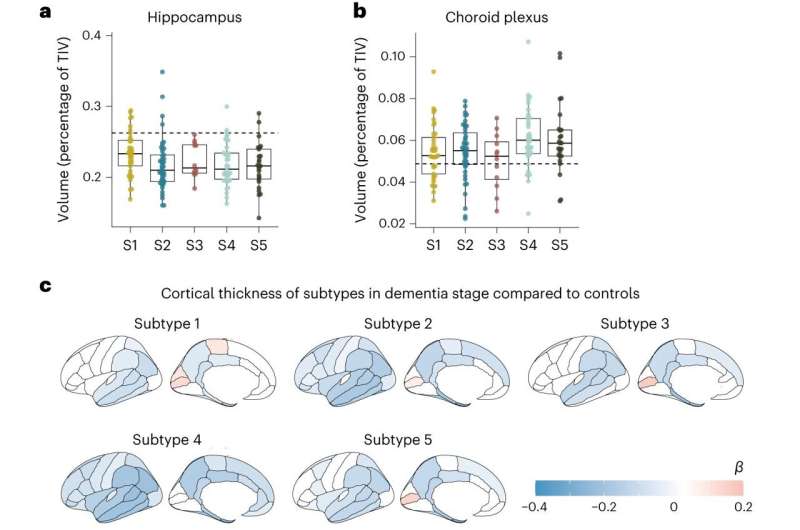January 13, 2024 report
This article has been reviewed according to Science X's editorial process and policies. Editors have highlighted the following attributes while ensuring the content's credibility:
fact-checked
peer-reviewed publication
trusted source
proofread
Differences in cerebrospinal fluid of Alzheimer's patients suggests possibility of variants

A large team of neuroscientists and neurodegenerative disease specialists affiliated with multiple entities across the Netherlands, working with colleagues from the U.S., Belgium, the U.K. and Sweden, has found five categories of fluid surrounding the brain in Alzheimer's patients. Their study is published in the journal Nature Aging.
Prior research has shown that people who develop Alzheimer's disease have differences in protein levels in their cerebrospinal fluid compared to people without the disease—differences associated with certain molecular processes in the brain. In this new effort, the research team discovered differences in protein levels among patients who had the disease.
The work involved studying 1,058 proteins in cerebrospinal fluid from 419 patients and 187 control volunteers known to be different for Alzheimer's patients when they noticed some patterns developing. The patterns, they found, could be divided into five distinct subtypes, suggesting that there may be five distinct types of Alzheimer's disease. They named the subtypes 1 through 5.
More specifically, the researchers found that patients with subtype 1 had altered levels of proteins associated with hyperplasticity in addition to increased levels of amyloid production. Those with subtype 2 had proteins associated with innate immune activation associated with excessive pruning of microglia synapses and proteins. Subtype 3 patients showed signs of RNA dysregulation, while subtype 4 patients showed signs of choroid plexus (where cerebrospinal fluid is made) dysfunction. And subtype 5 patients had impairments in the blood-brain barrier along with reduced levels of amyloid production.
The research team noted that each of the subtypes also had a unique associated genetic profile. They also suggest that if Alzheimer's disease has five major types, it could explain why finding therapies to treat it has met with so little success, pointing out that a different therapy may be needed for each subtype. They further suggest that treatment for future Alzheimer's patients might begin by first testing their cerebrospinal fluid and identifying their subtype.
More information: Betty M. Tijms et al, Cerebrospinal fluid proteomics in patients with Alzheimer's disease reveals five molecular subtypes with distinct genetic risk profiles, Nature Aging (2024). DOI: 10.1038/s43587-023-00550-7
© 2024 Science X Network




















